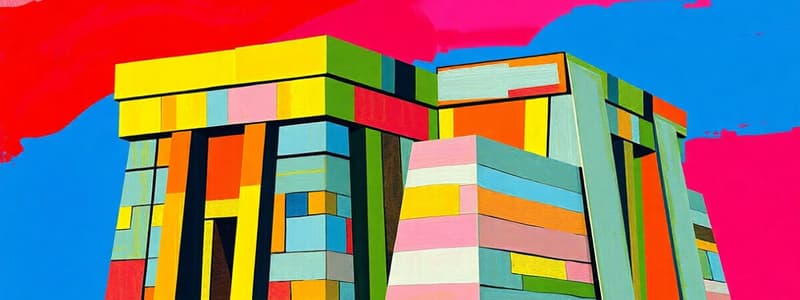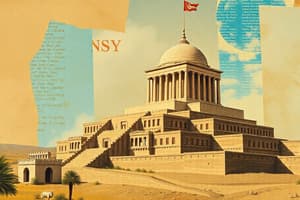Podcast
Questions and Answers
What primary purpose did ziggurats serve in Mesopotamian civilization?
What primary purpose did ziggurats serve in Mesopotamian civilization?
- Military fortifications
- Observatories and places of worship (correct)
- Centers for political gatherings
- Residential spaces for the elite
Which feature is NOT commonly associated with Mesopotamian sculptures?
Which feature is NOT commonly associated with Mesopotamian sculptures?
- Depiction of gods and rulers
- Large eyes
- Dynamic poses (correct)
- Static poses
What material was predominantly used in the construction of Mesopotamian buildings?
What material was predominantly used in the construction of Mesopotamian buildings?
- Stone
- Wood
- Clay and bricks (correct)
- Concrete
What aspect of Mesopotamian palaces is emphasized in their architectural design?
What aspect of Mesopotamian palaces is emphasized in their architectural design?
Which section is likely to be found in a reconstructed Mesopotamian palace?
Which section is likely to be found in a reconstructed Mesopotamian palace?
Flashcards
What is a ziggurat?
What is a ziggurat?
A large, stepped tower in ancient Mesopotamia, typically dedicated to a god or goddess. They served as observatories, places of worship, and possibly centers for divination.
Why were Mesopotamian buildings constructed on platforms or terraces?
Why were Mesopotamian buildings constructed on platforms or terraces?
These structures were built to protect the buildings from floods. They were often elevated platforms upon which structures were erected.
What were the key architectural innovations used by Mesopotamian builders?
What were the key architectural innovations used by Mesopotamian builders?
Mesopotamians were skilled in using these, incorporating them into their architecture to create strong and stable structures.
What was the primary building material used by the Mesopotamians?
What was the primary building material used by the Mesopotamians?
Signup and view all the flashcards
Describe the typical design of a Mesopotamian Palace.
Describe the typical design of a Mesopotamian Palace.
Signup and view all the flashcards
Study Notes
Mesopotamian Civilization
- Mesopotamian buildings were made of fragile materials like clay and bricks, leading to few surviving archaeological remains.
- Buildings were constructed on platforms/terraces to protect against floods.
- Mesopotamians invented arches and vaults for structures.
- Ziggurats were large, stepped towers, possibly for astronomical observation, worship, or divination.
- Ziggurats were near temples.
- Palaces were organized around courtyards, surrounded by walls.
- Sculptures usually depicted rulers, gods, or officials, often with large eyes and a static appearance.
- Reliefs displayed important events in political or religious Mesopotamian life.
Palace of Lagash
- The palace was constructed around 2600 BC.
- Its construction is depicted in a reconstruction.
- Key areas include an entrance, courtyard, temples, ziggurat, living/service areas, throne room, and defensive wall.
Building Materials and Design
- Buildings used materials like clay, bricks, and possibly arches or vaults.
- Structures were strategically placed on platforms.
Artistic Depictions
- Sculptures often portrayed rulers or gods, with large eyes and static postures.
- Reliefs showcased historical events and religious/political moments.
Studying That Suits You
Use AI to generate personalized quizzes and flashcards to suit your learning preferences.




